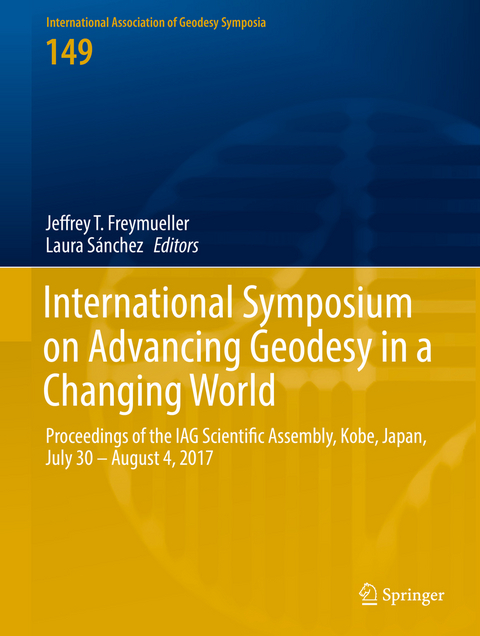
International Symposium on Advancing Geodesy in a Changing World
Springer International Publishing (Verlag)
978-3-030-12914-9 (ISBN)
These proceedings contain 23 papers, which are the peer-reviewed versions of presentations made at the Joint Scientific Assembly of the International Association of Geodesy (IAG) and the International Association of Seismology and Physics of the Earth's Interior (IASPEI). The assembly was held from 30 July to 4 August 2017 in Kobe, Japan. The scientific assembly included seven symposia organized by IAG, and nine joint symposia, along with additional symposia organized by IASPEI.
The IAG symposia were structured according to the four IAG Commissions and the three GGOS Focus Areas, and included reference frames, static and time-variable gravity field, Earth rotation and geodynamics, multi-signal positioning, geodetic remote sensing, and GGOS. The joint symposia included monitoring of the cryosphere, studies of earthquakes, earthquake source processes, and other types of fault slip, geohazard warning systems, deformation of the lithosphere, and seafloor geodesy. Together, the IAG and joint symposia spanned a broad range of work in geodesy and its applications.
Part 1: Reference Frames.- Chapter 1: DGFI-TUM analysis and scale investigations of the latest terrestrial reference frame realizations.- Chapter 2: Impact of different ITRS realizations on VLBI combined EOP and Scale.- Chapter 3: Testing special relativity with geodetic VLBI.- Chapter 4: Development of wideband antennas.- Part 2: Static Gravity Field.- Chapter 5: Boundary complexity and kernel functions in classical and variational concepts of solving geodetic boundary value problems.- Chapter 6: GEOMED2: high-resolution geoid of the Mediterranean.- Chapter 7: Evaluation of altimetry data in the Baltic Sea region for computation of new quasigeoid models over Poland.- Chapter 8: AFRGDB V2.0: The gravity database for the geoid determination in Africa.- Chapter 9: Combined use of a superconducting gravimeter and Scintrex gravimeters for hydrological correction of precise gravity measurements - A superhybrid gravimetry.- Chapter 10: Evaluation of the global altimetric marine gravity fieldDTU15 - using Marine gravity and GOCE satellite gravity.- Part 3: Time variable gravity field.- Chapter 11: Status of development of the future accelerometers for next generation gravity missions.- Chapter 12: On computation of potential, gravity and gravity gradient from GRACE inter-satellite ranging data: A systematic study.- Chapter 13: Calibration of GRACE accelerometers using two types of reference accelerations.- Part 4: Geodetic remote sensing.- Chapter 14: Performance analysis of regional versus global Numerical Weather Model tropospheric prediction in GPS analysis.- Chapter 15: Calibration of empirical models of thermospheric density using satellite laser ranging observations to near-Earth orbiting spherical satellites.- Chapter 16: Geodetic remote sensing of ionosphere in relation to space weather and seismic activity in Bosnia and Herzegovina.- Chapter 17: Comparing the Nigerian GNSS reference network's zenith total delays from precise point positioning to a numerical weather model.- Part 5: Global Geodetic Observing System (GGOS) and Earth monitoring services.- Chapter 18: GGOS Bureau of Products and Standards: Recent activities and future plans.- Chapter 19: Recent activities of the GGOS Standing Committee on Performance Simulations and Architectural Trade-Offs (PLATO).- Chapter 20: IGFS metadata for gravity. Structure, build-up and application module.- Part 6: Multi-signal positioning: Theory and applications.- Chapter 21: Assessment of GNSS and map integration for lane-level applications in the scope of Intelligent Transportation Location Based Services (ITLBS).- Chapter 22: Improving low-cost GNSS navigation in urban areas by integrating a Kinect device.- Chapter 23: Crustal deformation and fault models of the 2016 Kumamoto earthquake sequence: Foreshocks and main shock.
| Erscheinungsdatum | 14.03.2019 |
|---|---|
| Reihe/Serie | International Association of Geodesy Symposia |
| Zusatzinfo | IX, 206 p. 105 illus., 82 illus. in color. |
| Verlagsort | Cham |
| Sprache | englisch |
| Maße | 210 x 279 mm |
| Gewicht | 769 g |
| Themenwelt | Naturwissenschaften ► Geowissenschaften ► Geografie / Kartografie |
| Naturwissenschaften ► Geowissenschaften ► Geologie | |
| Naturwissenschaften ► Geowissenschaften ► Geophysik | |
| Schlagworte | earthquakes • Geodesy • Geoid • Mass Distribution and Displacements • reference frames • Remote Sensing/Photogrammetry |
| ISBN-10 | 3-030-12914-4 / 3030129144 |
| ISBN-13 | 978-3-030-12914-9 / 9783030129149 |
| Zustand | Neuware |
| Informationen gemäß Produktsicherheitsverordnung (GPSR) | |
| Haben Sie eine Frage zum Produkt? |
aus dem Bereich


